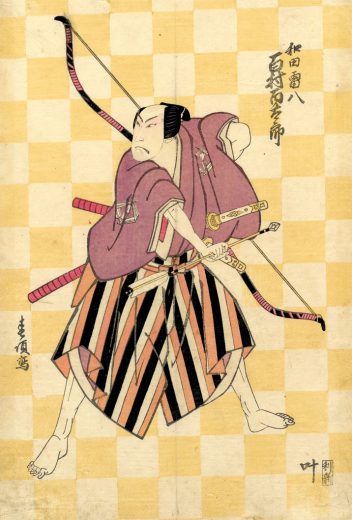Ukiyo-e from various aspects: The Color Yellow
Sep 3 (Tue) – Dec 1 (Sun), 2019
This museum exhibits ukiyo-e prints and paintings produced in Osaka in the Edo period. Most of the ukiyo-e prints made in Osaka are portraits of kabuki actors performing in kabuki theatres around Dotombori.
Ukiyo-e is drawn on woodblocks, and the woodblocks are made the same number of colors used in an ukiyo-e. In ukiyo-e portraits, there drawn not only actors but also gorgeous costumes, stage settings and props. Ukiyo-e describes extreme coloring of a stage with limited number of colors.
In this feature exhibition, we focus on the color yellow in ukiyo-e. Bright color yellow not only represents dazzling gold but also complements other colors. Enjoy the color yellow which sheds light on actors in ukiyo-e.

“Keisei Yamato Soshi”, Drawn by Syuncho
The color yellow in ukiyo-e
To paint yellow in ukiyo-e, turmeric, gamboge and orpiment are mainly used.
Turmeric is yellow dye made from its rhizomes. It is bright yellow and is also used for curries. Curcumin is a chemical component of turmeric that is yellow.
Gamboge is made from resin extracted from a trunk of tropical trees and is also used as medicine for skin disease and burn.
Orpiment is a mineral dye, hydrogen sulfide. It is translucent and glossy yellow, used for traditional Japanese painting. It is arsenic therefore toxic.
It is difficult to distinguish these colors by the naked eye but they are all bright yellow used in ukiyo-e.
Yellow that colors autumn in the kabuki plays
One of the charms of kabuki plays is a beautiful stage settings with tastes of four seasons that brings the feast for the eyes. Among them autumn is a season of leaves of different colors, especially shiny yellow.
According to the lunar calendar, the ninth of September, the day of “choyo no sekku”, is also called “kiku no sekku” (chrysanthemum festival). On this day people hole an event to admire chrysanthemums and wish for a long life. In the Edo period gardening became popular and people did breed improvements and appreciated chrysanthemums. This trend influenced on kabuki world, you can see the kabuki stage with beautiful chrysanthemums in ukiyo-e.
Enjoy the color yellow in kabuki plays; the bright yellow of Patrina Scablosaefolia, one of the seven herbs of autumn, beautiful bright moonlight that shines the night sky and the yellow autumn leaves that complement the red ones.
Mixing blue with yellow
The color green in ukiyo-e is produced by mixing blue with yellow, not by using the material that develops green.
“Imayo mitate shinokosho”, drawn by Utagawa Toyokuni III, is a description of process of producing ukiyo-e. In this ukiyo-e, you can find a line of paint bowls including bowls of green paint at a painter’s workplace.
Another way of making green is to print blue after printing yellow. Look at “Hiragana Seisuiki” (part) with arrow feather pattern on its background; it’s the way of using mixing colors.
yellow point
Kihachijo Silk fabric that is woven vertical stripe or plaid pattern with its base color yellow, brown and black. It was very popular as it was used for kabuki costumes.
Kitabi (yellow socks) Usually white but depends on the role actors wear colored socks. In famous kabuki play “sukeroku”, yellow socks dyed with turmeric are used. It was considered stylish to wear short socks with actor’s ankles visible.
Kitsubushi To print background of a character with one color is called “jitsubushi”. To print background of a character with yellow is called “kitsubushi” (yellow-out)